Solanum demissum
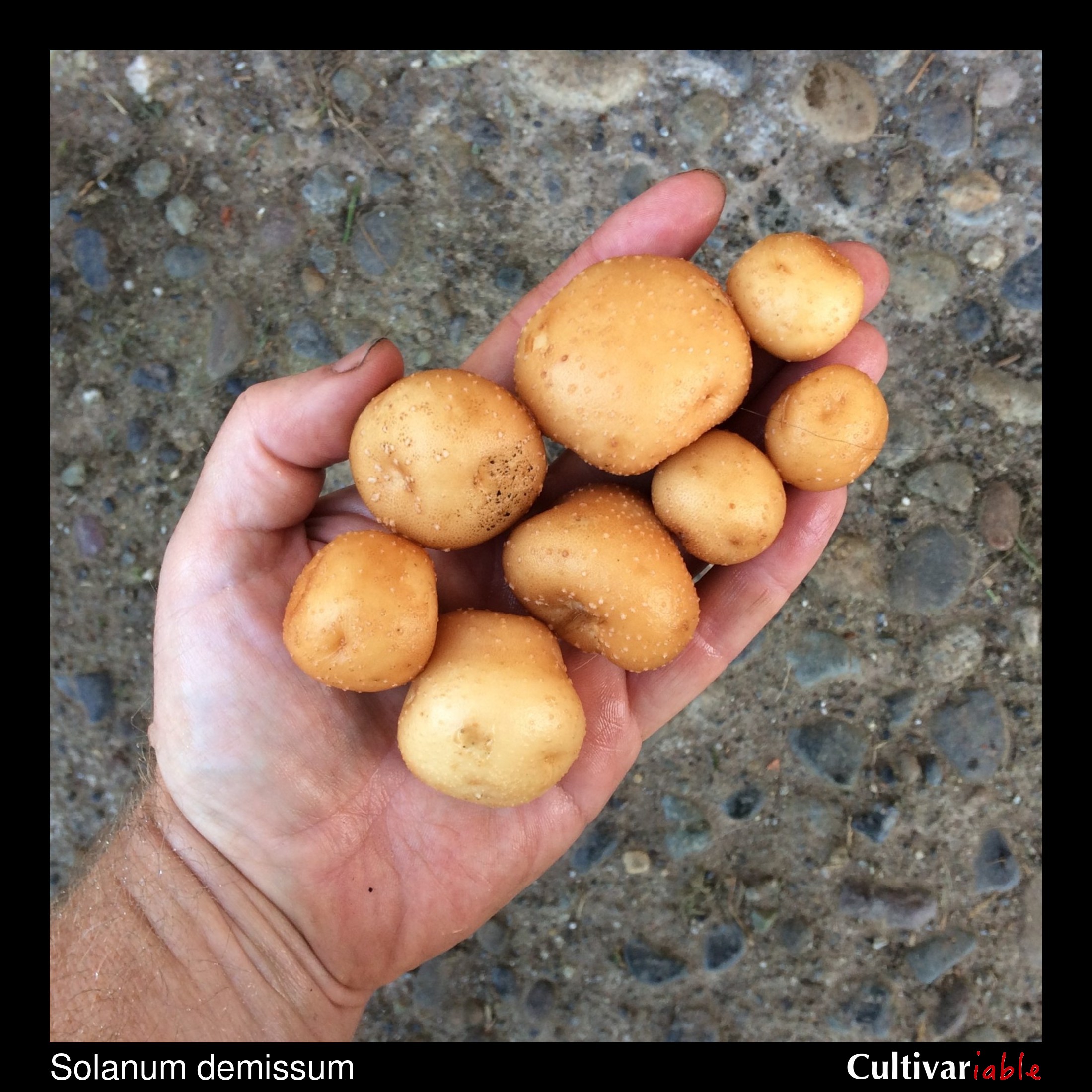
| Common Names | Papa cimarrona, papa del monte |
| Code | dms, dem |
| Synonyms | S. alpicum, S. semidemissum, S. utile |
| Clade | Mixed |
| Series | Demissa |
| Ploidy | Hexaploid (6x) |
| EBN | 4 |
| Tuberization Photoperiod | Unknown |
| Self-compatibility | Yes |
| Nuclear Genome | A |
| Cytoplasmic Genome | D |
| Citation | Lindley: J. Hort. Soc. London 3: 70, fig. pg. 69. 1848. |
Description
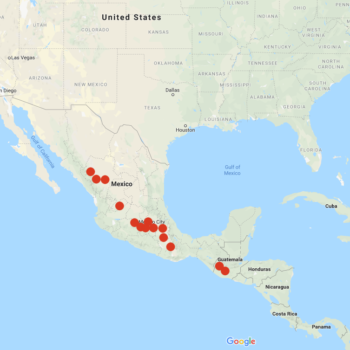
Solanum demissum (demissum meaning “low lying”) is a widespread species in Mexico, particularly densely in central Mexico, and reaching south into Guatemala. Plants reach about 18 inches tall, although many take on a much more compact or rosette form. Flowers violet to purple. Stolons long, two feet or more. Tubers are white to tan, round to compressed. Tuber size often reaches two to three inches.
The specific epithet, demissum, means “low lying.” It is formed from the Latin word “demissus,” for “low.” While there is no completely standardized pronunciation for scientific names, the most common way to pronounce this species is probably so-LAY-num deh-MISS-um.
This species is more closely related to S. acaule and S. albicans than to other Mexican species, which is quite interesting given the very long distance between the natural ranges of those species.
Both tubers and cooked fruits are reportedly consumed in Mexico. Glycoalkaloids can be rather high in this species so I recommend that you refrain from eating large amounts. Because there are almost no published measurements of glycoalkaloids in potato berries, I would also be very careful with those. The people who traditionally eat this species may know more than we do about how and when it can be done safely.
This species was long thought to be an allopolyploid, bearing both the A and B genomes. More recent work has shown that it is an autopolyploid, with only the A genome (Rodriguez 2009). The chromosomes of this species form three sets of bivalents (He 2018).
Subramanian (2017) found that at least some accessions of this species have unusually high dry matter content.
S. demissum is probably the female parent of the hybrid species S. x edinense.
Resistances
To date, eleven discrete resistance genes (R1 to R11) to late blight have been introduced to S. tuberosum from S. demissum. The major late blight resistance gene in this species is R1.
This species can survive frosts down to 25 degrees F (-4 C) (Li 1977). Vega (1995) found that this species is much more frost tolerant than domesticated potato.
| Condition | Type | Level of Resistance | Source |
|---|---|---|---|
| Alternaria solani (Early Blight) | Fungus | Somewhat resistant | Jansky 2008 |
| Drought | Abiotic | Somewhat resistant | Machida-Hirano 2015 |
| Frost | Abiotic | Somewhat resistant | Machida-Hirano 2015 |
| Globodera pallida (Pale Cyst Nematode) | Invertebrate | Somewhat resistant | Castelli 2003, Bachmann-Pfabe 2019 |
| Globodera rostochiensis (Potato Cyst/Golden Nematode) | Invertebrate | Somewhat resistant | Castelli 2003 |
| Leptinotarsa decemlineata (Colorado Potato Beetle) | Invertebrate | Somewhat resistant | Machida-Hirano 2015 |
| Meloidogyne spp. (Root Knot Nematode) | Invertebrate | Somewhat resistant | Machida-Hirano 2015 |
| Pectobacterium carotovorum (Blackleg/Soft Rot) | Bacterium | Somewhat resistant | Chung 2011, Machida-Hirano 2015 |
| Phytophthora infestans (Late Blight) | Fungus | Resistant | Gonzales 2002, Bachmann-Pfabe 2019 |
| Potato Leaf Roll Virus (PLRV) | Virus | Somewhat resistant | Machida-Hirano 2015 |
| Potato Virus X (PVX) | Virus | Somewhat resistant | Machida-Hirano 2015 |
| Potato Virus Y (PVY) | Virus | Resistant | Machida-Hirano 2015 |
| Potato Virus Y (PVY) | Virus | Not resistant | Cai 2011 |
| Synchytrium endobioticum (Wart) | Fungus | Somewhat resistant | Machida-Hirano 2015 |
Glykoalkaloid content
Sarquis (2000) measured the total glycoalkaloid content of tubers of an accession of this species at 70.4 mg / 100g, a level 3.5 times the safety limit. The tubers that I have tasted were not terribly bitter and I can imagine making edible selections of this species without too much trouble.
Images
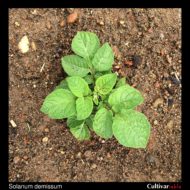 |
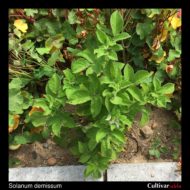 |
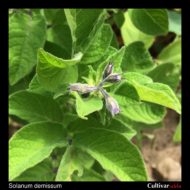 |
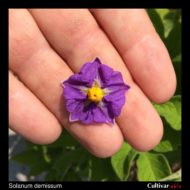 |
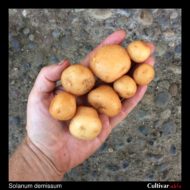 |
|||
Cultivation
I have found S. demissum difficult to germinate, with often low germination percentage and a prolonged germination period.
Towill (1983) found that seeds of this species stored at 1 to 3 degrees C germinated at 60 to 98% after 20 years.
This species typically has four to five months of dormancy.
Breeding
This is one of the most frequently used species in potato breeding and has been included in the pedigrees of at least 58 hybrid cultivars of Solanum tuberosum. It was particularly popular in pre-WW2 German potato breeding and the resulting crosses were known as the “W races.” Cultivars with a genetic contribution include Ashworth, Boone, Chenango, Cortland, Empire, Essex, Fillmore, Glenmeer, Hartford, Madison, Placid, Snowdrift, Virgil (Hougas 1956), Agassiz, Alasclear, Allagash Russet, Avon, Belleisle, BelRus, Campbell 12, Canso, Caribe, Cariboo, Cascade, Centennial Russet, Crystal, Dakchip, Denali, Fundy, Highlat Russet, Hunter, Keswick, Pennchip, Pennrose, Penobscot, Raritan, Sable, Sunrise, Tobique, Yankee Supreme, York (Plaisted 1989), CalWhite, Cascade, Centennial Russet, Chipeta, Frontier Russet, Itasca, Nooksack, and Russet Norkotah (Love 1999). In addition, the following varieties inherited S. demissum genetics through the German W race potatoes, derived from Solanum x edinense: Acadia Russet, Agassiz, Alamo, Allagash Russet, Arenac, Atlantic, Avon, Bake King, Belchip, Belleisle, Bison, Blanca, Campbell 11, Campbell 12, Campbell 14, Caribe, Carlton, Catoosa, Centennial Russet, Chinook, Chipbelle, Crystal, Denali, Elba, Emmet, Erik, Fundy, Grand Falls, Hampton, Highlat Russet, Hudson, Hunter, Islander, Jemseg, Jewel, Krantz, Lemhi Russet, Lenape, Nampa, Navajo, Nooksack, Norchief, Norking Russet, Onaway, Oneida, Pennrose, Redsen, Reliance, Rhinered, Russette, Sable, Seminole, Shepody, Shoshoni, Simcoe, Snowflake, Sunrise, Superior, Targhee, Trent, Wischip, Yankee Chipper, Yankee Supreme, York (Plaisted 1989).
Watanabe (1991) found that 2.3% of varieties of this species produced 2n pollen and Jackson (1999) found 3-9%, which would be effectively dodecaploid and 8EBN.
Crosses with S. tuberosum
| Female | Male | Berry Set |
Seed Set | Germ | Ploidy | Source |
|---|---|---|---|---|---|---|
| S. demissum | S. tuberosum | Moderate | High | Jackson (1999) | ||
| S. tuberosum | S. demissum | Low | Moderate | Jackson (1999) |
Crosses with other species
| Female | Male | Berry Set |
Seed Set | Germ | Ploidy | Source |
|---|---|---|---|---|---|---|
| S. commersonii 3x | S. demissum | Yes | Yes | Yes | Reddick 1939, Black 1945 | |
| S. demissum | S. chacoense | Yes | Yes | Reddick 1939 |
References
Solanum demissum at Solanaceae Source
